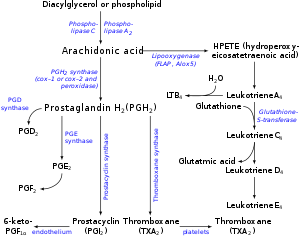Prostaglandin

Prostaglandins (PG) are a group of
The structural differences between prostaglandins account for their different biological activities. A given prostaglandin may have different and even opposite effects in different tissues in some cases. The ability of the same prostaglandin to stimulate a reaction in one tissue and inhibit the same reaction in another tissue is determined by the type of
Prostaglandins are powerful, locally-acting
Specific prostaglandins are named with a letter indicating the type of ring structure, followed by a number indicating the number of double bonds in the hydrocarbon structure. For example, prostaglandin E1 has the abbreviation PGE1 and prostaglandin I2 has the abbreviation PGI2.
History and name
Systematic studies of prostaglandins began in 1930, when Kurzrock and Lieb found that human seminal fluid caused either stimulation or relaxation of strips of isolated human uterus. They noted the curious finding that uteri from patients who had gone through successful pregnancies responded to the fluid with relaxation, while uteri from sterile women responded with contraction upon addition of this seminal fluid.
In 1971, it was determined that
Biochemistry
Biosynthesis

Prostaglandins are found in most tissues and organs. They are
Release of prostaglandins from the cell
Prostaglandins were originally believed to leave the cells via passive diffusion because of their high lipophilicity. The discovery of the
Cyclooxygenases
Prostaglandins are produced following the sequential oxygenation of arachidonic acid, DGLA or EPA by cyclooxygenases (COX-1 and COX-2) and terminal prostaglandin synthases. The classic dogma is as follows:
- COX-1is responsible for the baseline levels of prostaglandins.
- COX-2produces prostaglandins through stimulation.
However, while COX-1 and COX-2 are both located in the
Prostaglandin E synthase
Prostaglandin E2 (PGE2) — the most abundant prostaglandin[10] — is generated from the action of prostaglandin E synthases on prostaglandin H2 (prostaglandin H2, PGH2). Several prostaglandin E synthases have been identified. To date, microsomal (named as misoprostol) prostaglandin E synthase-1 emerges as a key enzyme in the formation of PGE2.[citation needed]
Other terminal prostaglandin synthases
Terminal prostaglandin synthases have been identified that are responsible for the formation of other prostaglandins. For example, hematopoietic and
Functions
There are currently ten known
The diversity of receptors means that prostaglandins act on an array of cells and have a wide variety of effects such as:
- create eicosanoids hormones
- acts on thermoregulatory center of hypothalamus to produce fever
- increases mating behaviors in goldfish[13]
- Prostaglandins are released during endometrial cells, and the resultant release of their contents.[14][needs update] Release of prostaglandins and other inflammatory mediators in the uterus cause the uterus to contract. These substances are thought to be a major factor in primary dysmenorrhea.[15][16][17]
Types
The following is a comparison of different types of prostaglandin, including prostaglandin I2 (prostacyclin; PGI2), prostaglandin D2 (PGD2), prostaglandin E2 (PGE2), and prostaglandin F2α (PGF2α).[18]
| Type | Receptor | Receptor type | Function |
|---|---|---|---|
PGI2
|
IP | Gs
|
|
| PGD2 | PTGDR (DP1) and CRTH2 (DP2) | GPCR
|
|
| PGE2 | EP1
|
Gq
|
|
| EP2 | Gs
|
| |
EP3
|
Gi
|
||
| Unspecified | |||
| PGF2α | FP | Gq
|
|
Role in pharmacology
Inhibition
Examples of prostaglandin antagonists are:
- COX-2 selective inhibitorsor coxibs
- Corticosteroids (inhibit phospholipase A2production)
- Cyclopentenone prostaglandins may play a role in inhibiting inflammation
Clinical uses
Synthetic prostaglandins are used:
- To induce childbirth (parturition) or abortion (PGE2 or PGF2(misoprostol), with or without mifepristone, a progesterone antagonist)
- Induction of labour[27]
- To prevent closure of ductus arteriosus in newborns with particular cyanotic heart defects (PGE1)
- As a vasodilator in severe Raynaud syndrome or ischemia of a limb
- In pulmonary hypertension
- In treatment of glaucoma (as in bimatoprost ophthalmic solution, a synthetic prostamide analog with ocular hypotensive activity) (PGF2α)
- To treat alprostadil).[28]
- To measure erect penis size in a clinical environment[29]
- To treat egg binding in small birds[30]
Synthesis
The original synthesis of prostaglandins F2α and E2 is shown below. It involves a Diels–Alder reaction which establishes the relative stereochemistry of three contiguous stereocenters on the prostaglandin cyclopentane core.[31]

Prostaglandin stimulants
Cold exposure and IUDs may increase prostaglandin production.[32]
See also
- Oxaprostaglandin, a type of prostaglandin
- Prostamides, a chemically related class of physiologically active substances
References
- ^ "Eicosanoid Synthesis and Metabolism: Prostaglandins, Thromboxanes, Leukotrienes, Lipoxins". themedicalbiochemistrypage.org. Retrieved 2018-09-21.
- ^ PMID 21508345.
- ISBN 0-87893-617-3.
- S2CID 85374636.
- S2CID 38622866.
- PMID 16994667.
- ISBN 978-0-230-30466-6.
- S2CID 220151673.
- ISBN 3-527-29284-5.
- PMID 27230680.
Prostaglandin E2 (PGE2) is the most abundant prostanoid in the human body
- PMID 14979715.
- PMID 16475787.
- ^ "Hormonal and pheromonal control of spawning in goldfish (PDF Download Available)". ResearchGate. Retrieved 2017-02-04.
- PMID 23440779.
- ISBN 0-7817-4363-X[page needed]
- PMID 17174824.
- PMID 31535715.
- S2CID 1513449.
- ^ ISBN 0-443-07145-4.
- PMID 11238561.
- PMID 17242161.
- PMID 32714206.
- ISBN 978-0-323-05908-4.
- PMID 34206530.)
{{cite journal}}: CS1 maint: multiple names: authors list (link - PMID 8240383.)
{{cite journal}}: CS1 maint: multiple names: authors list (link - PMID 20046582.)
{{cite journal}}: CS1 maint: multiple names: authors list (link - ^ "WHO Recommendations for Induction of Labour". NCBI Bookshelf. Retrieved 2020-07-15.
Induction of labour is defined as the process of artificially stimulating the uterus to start labour (1). It is usually performed by administering oxytocin or prostaglandins to the pregnant woman or by manually rupturing the amniotic membranes.
- ^ Medscape Early Penile Rehabilitation Helps Reduce Later Intractable ED
- PMID 25487360.
- ^ LaBonde, MS, DVM, Jerry. "Avian Reproductive and Pediatric Disorders" (PDF). Michigan Veterinary Medical Association. Archived from the original (PDF) on 2008-02-27. Retrieved 2008-01-26.
{{cite web}}: CS1 maint: multiple names: authors list (link) - PMID 5808505.
- ISBN 978-0-7817-9026-0.
External links
- Prostaglandins at the U.S. National Library of Medicine Medical Subject Headings (MeSH)
